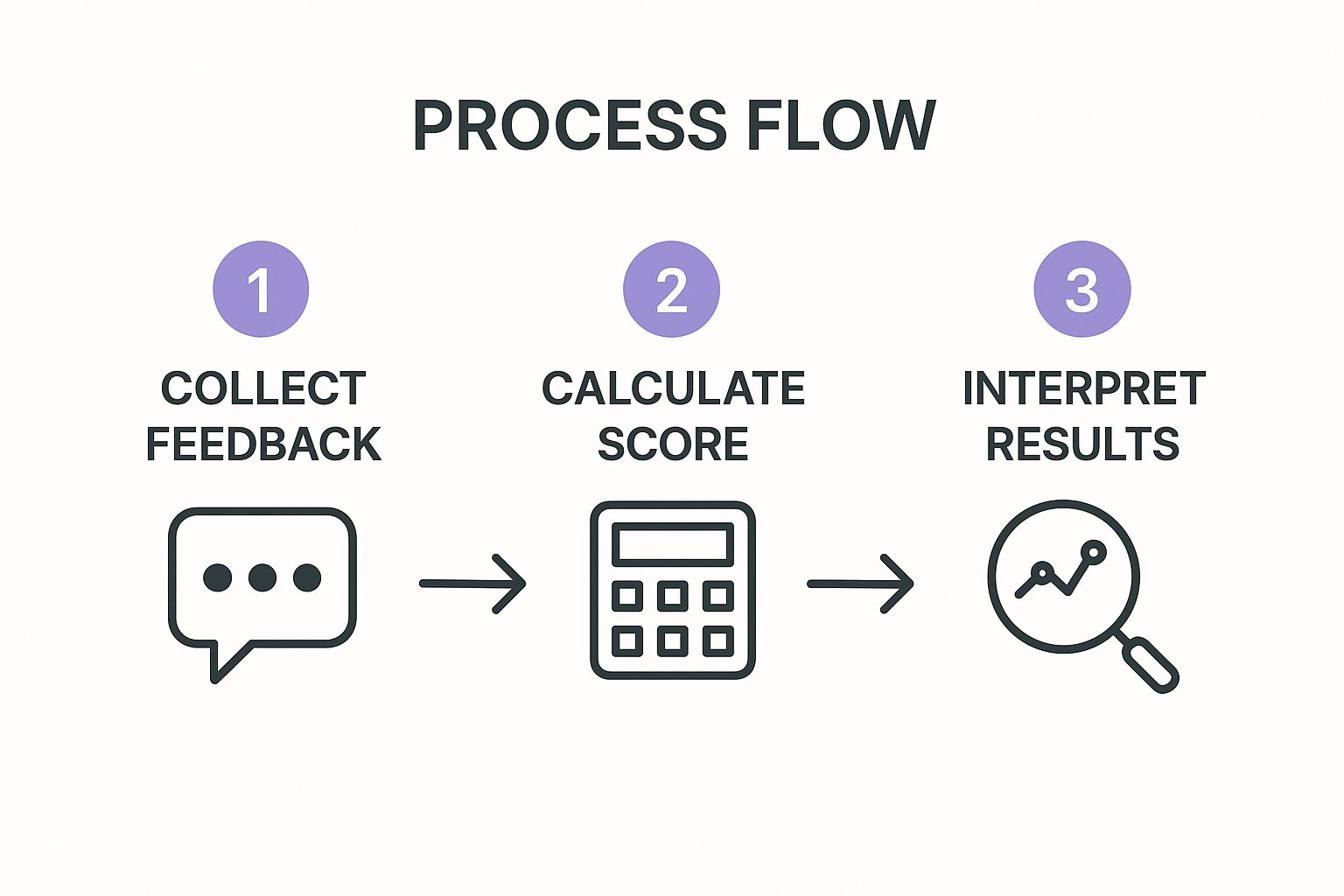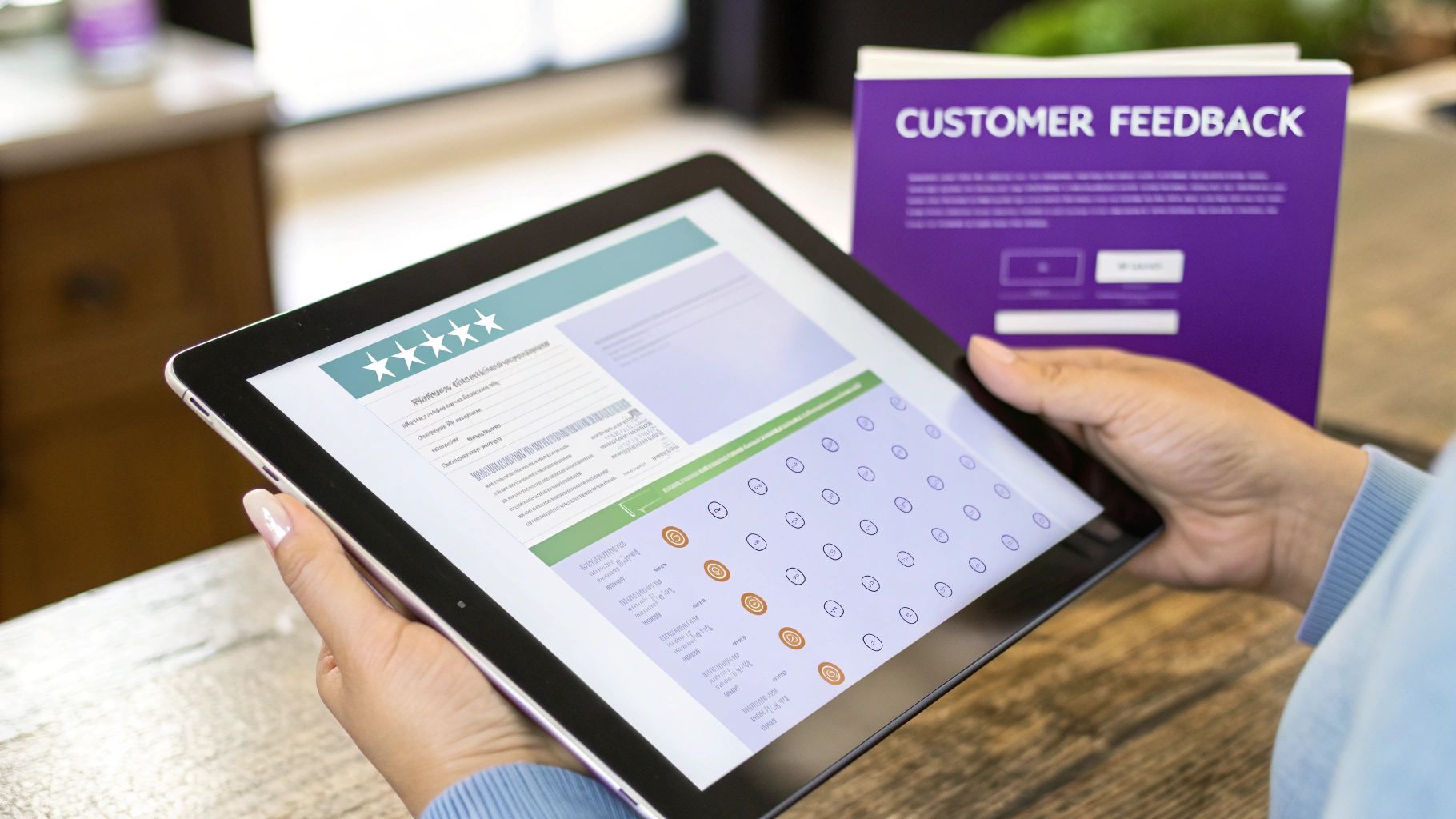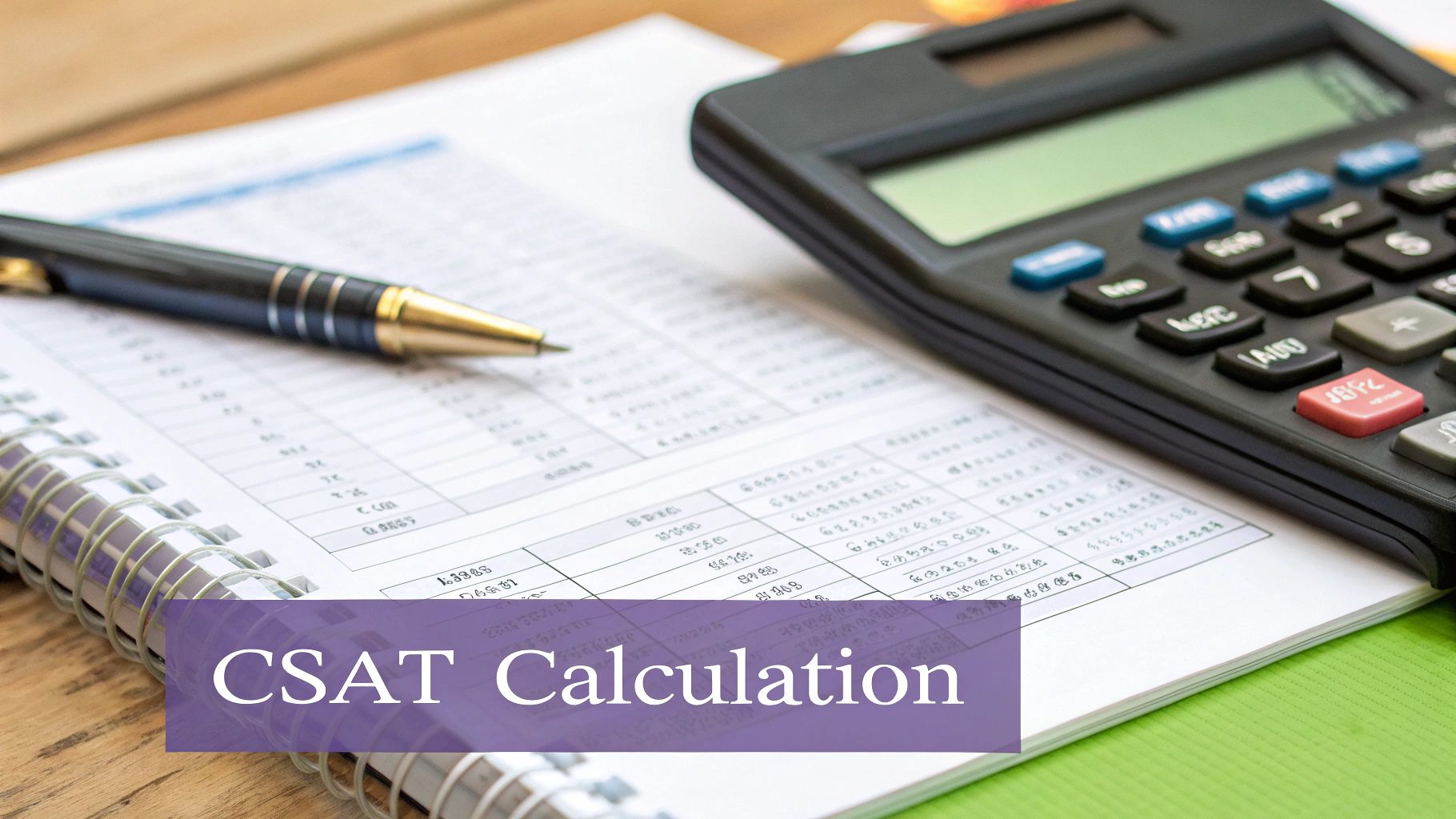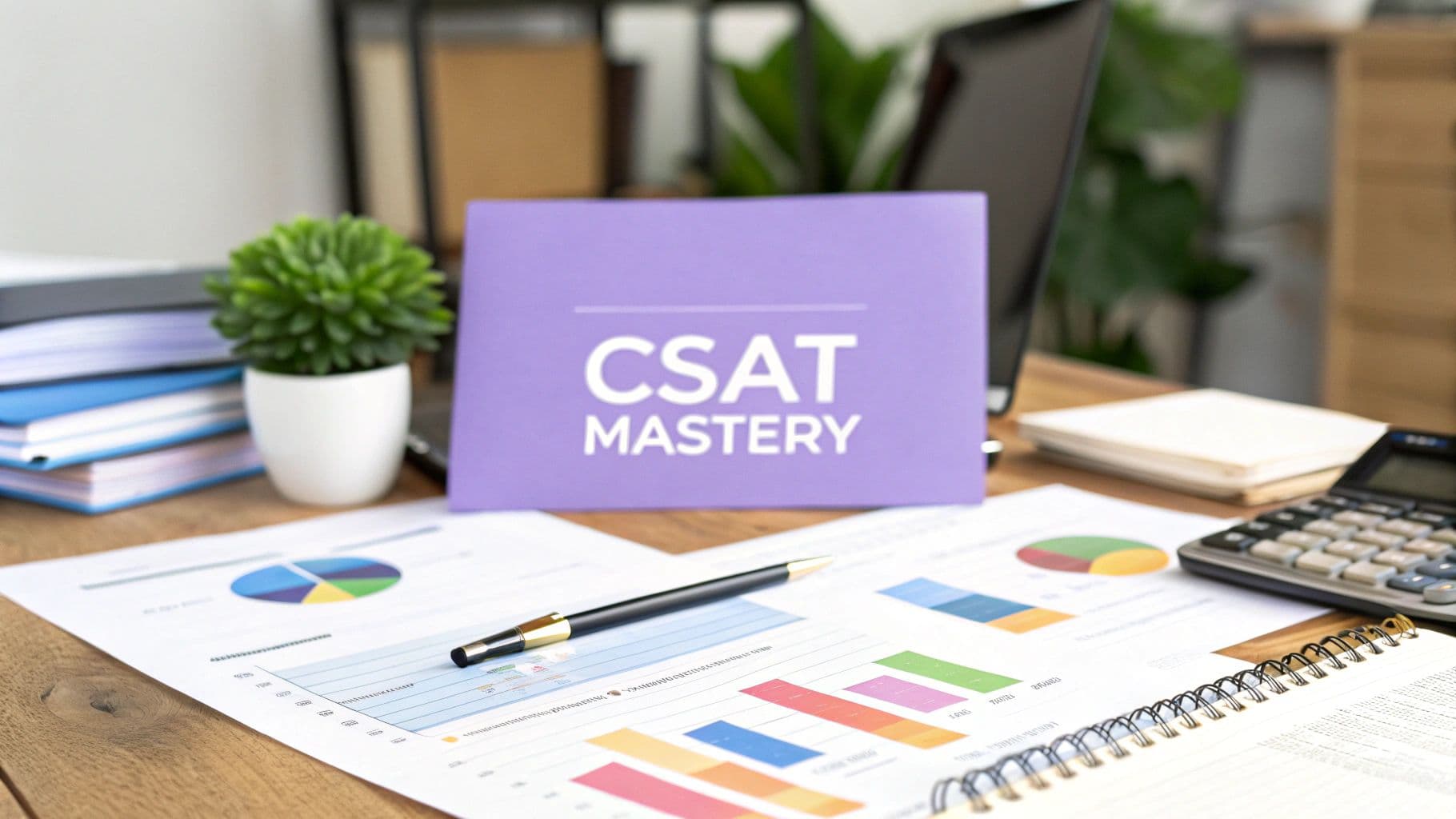At its core, the customer satisfaction score is a beautifully simple calculation. You just divide the number of happy customers by the total number of people who answered your survey, then multiply that by 100. This one move turns a pile of raw feedback into a clean percentage that tells you how people feel about a specific interaction, product, or service.
Calculating Your Customer Satisfaction Score
The whole point of the CSAT calculation is to transform survey responses into a metric that’s clear and actionable. This isn't about getting lost in complex statistics; it's about a straightforward formula that gives you a direct signal from your customers. Getting this process down ensures you can reliably measure and track satisfaction over time, which is exactly what you need to drive improvement.
The Standard CSAT Formula
The most common way to calculate CSAT zeroes in on your satisfied customers. We’re talking about a metric built on a simple survey question asking how satisfied someone was, usually on a 1-to-5 scale. To get your score, you take the number of people who gave you a 4 or a 5, divide that by the total number of survey responses you received, and multiply by 100.
Let's walk through a real-world scenario. Imagine you run an e-commerce store and you’ve just sent a CSAT survey to customers who recently contacted your support team.
- You get 200 total responses back. Not bad.
- Digging into the data, you see that 150 of those customers rated their experience a 4 ("Satisfied") or a 5 ("Very Satisfied").
Plugging those numbers into the formula, your calculation is simple:
(150 Satisfied Customers / 200 Total Responses) x 100 = 75% CSAT Score
That 75% score is your new benchmark. It tells you, clear as day, that three-quarters of the customers who engaged with your support team and answered the survey walked away happy. While CSAT is a fantastic pulse-check, it’s always a good idea to explore various customer satisfaction measurement methods to get a more complete picture of customer sentiment.
For a quick reference, this table breaks down how the formula works.
CSAT Calculation at a Glance
| Component | Description | Example |
|---|---|---|
| Satisfied Customers | The total number of respondents who selected the top two satisfaction ratings (e.g., 4 or 5 on a 1-5 scale). | 150 customers |
| Total Responses | The complete number of survey responses you received for this specific survey. | 200 responses |
| The Formula | (Satisfied Customers / Total Responses) x 100 | (150 / 200) x 100 |
| Result (CSAT Score) | The final percentage representing overall satisfaction among respondents. | 75% |
As you can see, the math itself is the easy part. The real work is in collecting good data and then acting on the results.
From Data Collection to Interpretation
This journey from gathering feedback to understanding your score is a simple, three-stage process, as this visual shows.

The image really reinforces that calculating your CSAT is a streamlined flow: collect the raw data, plug it into the formula, and then use that final percentage to guide your business decisions. Think of it as a cycle that, when repeated, fuels continuous improvement.
Why CSAT Is a Critical Business Health Metric

Let's move beyond the formula for a second. Why should you really care about your CSAT score? I've seen too many businesses treat it as just another number for a quarterly report. In reality, it’s a direct pulse check on your company's health—and often, a leading indicator of future success or trouble on the horizon.
In a crowded market, knowing how your customers feel isn't optional. A slipping CSAT score is one of the earliest warning signs of customer churn. We’ve all seen the research: a huge chunk of customers will jump to a competitor after just one bad experience. That makes every single interaction a moment of truth.
The Worsening State of Customer Experience
The tough part? It’s getting harder to stand out. Recent data shows a pretty clear global decline in customer experience quality. This isn't just a gut feeling; the numbers back it up. Forrester's Global Customer Experience Index paints a concerning picture where brand experiences are, on the whole, getting worse.
Think about it:
- In North America, 25% of brands saw their CX scores drop for the second year in a row. Only a tiny 7% actually got better.
- In Europe, things are just stuck. A whopping 90% of brands' scores didn't budge, showing a massive lack of progress.
This trend creates a huge opening. If you can systematically improve your CSAT score while everyone else is stagnating, you build a powerful, lasting advantage.
A high CSAT score is a direct reflection of customer trust. I've heard CEOs say they prioritize that trust even over new product launches, because they know it’s the bedrock of long-term, sustainable growth.
Turning Satisfaction into a Strategic Asset
A great CSAT score does more than just keep customers around; it creates brand advocates. Happy customers don't just stay—they become a core part of your marketing engine through positive word-of-mouth.
This is where a disciplined approach to the customer satisfaction score calculation becomes a strategic weapon. It helps you pinpoint exactly where your service is shining and where it’s falling short. By slicing the data from different touchpoints—like after a support chat or a new purchase—you can get granular with your improvements.
To truly win, you have to create positive moments at every step. If you're looking for a roadmap, digging into the best practices for customer service in 2025 is a great place to start building a team that consistently delights.
At the end of the day, CSAT isn’t about looking backward. It’s about securing your company’s future by making sure the people who matter most—your customers—are genuinely happy. That focus on customer health is what builds resilient, thriving businesses.
How to Design Surveys That Get Real Answers

Let's be blunt: your customer satisfaction score calculation is only as good as the survey you use to get it. A poorly designed questionnaire won't just give you slightly off data—it'll give you completely misleading data, making the whole effort a waste of time.
To get the real, honest answers you need to make smart decisions, you have to be strategic. It's about asking the right thing, at the right time, in the right way.
The foundation is always a question that’s simple, direct, and completely neutral. You have to remove any bias. A question like, "How much did you love our amazing new feature?" is just patting yourself on the back. Instead, ask something clean and objective: "How satisfied are you with the new feature?"
Choosing the Right Moment to Ask
Timing is everything. I mean everything. Sending a survey at just the right moment captures the customer's true feelings while the experience is still fresh in their mind. This simple act can dramatically boost your response rates.
So, when should you strike? Here are a few moments I’ve found to be golden:
- Right after a support ticket is closed: This is the perfect time to get a read on your customer service team's performance.
- A few days after a product arrives: This gives the customer enough time to actually use the product but not so long that they've forgotten that initial unboxing experience.
- Immediately after they finish onboarding: You can find out right away if new users feel set up for success or if they're already confused.
Your goal is to make the survey feel like a natural part of the conversation, not a clunky, robotic interruption. By tying it to a specific, recent event, you show customers you care about their experience right now.
Crafting the Perfect Question
The wording of your primary question is the single most critical part of your survey. It absolutely has to be crystal clear.
Getting actionable insights means mastering the art of asking key CSAT survey questions. In my experience, a single, focused question almost always beats a complex one.
For example, a software company might ask, "How satisfied were you with the resolution provided by our support agent today?" It’s specific, it’s about a recent event, and it’s impossible to misinterpret. It laser-focuses the customer on one interaction, which is exactly what you want.
Selecting Your Rating Scale
How you let customers respond is just as important as the question you ask. The scale you choose can say a lot about your brand and what kind of interaction you're trying to create. The most important thing? Pick one and stick with it to keep your data consistent over time.
Here’s a quick breakdown of the most common scales I see:
| Scale Type | Description | Best For |
|---|---|---|
| Numerical (1-5) | The classic scale. 1 is "Very Dissatisfied" and 5 is "Very Satisfied." | Gathering standardized data that’s easy to calculate and track. |
| Star Ratings (1-5) | A visual, intuitive alternative to numbers, super common in e-commerce. | Brands that want a universally understood format that feels familiar to users. |
| Emojis/Faces | Uses expressive faces (like 😠, 😐, 😊) to capture satisfaction. | Engaging younger audiences or for brands with a more modern, playful personality. |
Ultimately, the best scale is the one your customers can understand and use in a split second. Don't make them think. The easier it is for someone to give you feedback, the more feedback you'll get. And that's how you get an accurate customer satisfaction score calculation.
Alright, you've calculated your Customer Satisfaction Score. You're looking at a percentage. Now what?
That number is a solid starting point, but on its own, it’s just a number. The real magic happens when you turn that single metric into a story about your customer experience. This is where you graduate from just measuring things to making smart, strategic decisions.
https://www.youtube.com/embed/8ANkDCHkjew
First, let's tackle the question everyone asks: "What’s a good CSAT score?"
While we all dream of a perfect 100%, a score floating between 75% and 85% is generally considered strong in most industries. But—and this is a big but—"good" is highly relative. The benchmark for a SaaS company is going to look very different from that of a local coffee shop or a healthcare clinic.
The most important thing to remember is that a single score on a single day doesn't tell you much. It's all about the trend. A CSAT score that's consistently climbing, even if it started low, is a much healthier sign than a high score that's starting to slip.
Go Deeper: Unlock Real Insights with Segmentation
To get information you can actually use, you have to slice and dice your data. Looking at your overall CSAT score is like viewing a forest from a helicopter—you get the big picture, but you can't see the individual trees. Segmentation is like walking through that forest to see which trees are thriving and which ones are struggling.
This is how you find the real strengths and weaknesses in your business.
Start by breaking down your scores by different criteria. This lets you ask much sharper questions.
- By Support Channel: Are customers happier with your email support than your AI chatbot? Maybe your chatbot needs a tune-up or your email team deserves a raise.
- By Product Line: Do people who buy your premium product report higher satisfaction than those who buy the entry-level one? This could point to a mismatch in expectations or a clunky onboarding process for your basic offering.
- By Customer Persona: Are new users constantly giving lower scores than your long-time power users? That’s a huge red flag that your initial user experience needs work.
Let’s say an e-commerce brand has a decent overall CSAT of 82%. That sounds pretty good, right? But after segmenting, they find that while post-purchase support is a fantastic 91%, satisfaction with the actual checkout process is a dismal 65%. Boom. Now they have a crystal-clear, high-impact problem to solve.
Connect the Dots: Tie CSAT to Your Bottom Line
The final step is to connect your satisfaction trends to other critical business metrics. Your CSAT score doesn't live in a bubble. When you track it alongside your main Key Performance Indicators (KPIs), you start to see the full picture of your company's health.
More importantly, it helps you prove the ROI of investing in customer experience.
Look for correlations between your CSAT and these metrics:
- Customer Churn Rate: You'll almost always see that as CSAT scores drop, customer churn starts to creep up.
- Customer Lifetime Value (CLV): It’s simple: happier customers stick around longer and spend more money.
- Repeat Purchase Rate: Satisfied customers come back. It's one of the most reliable growth levers you have.
By showing your team that a dip in satisfaction last quarter led directly to a rise in churn this quarter, you can make a powerful, data-backed case for investing in that new customer service initiative. This is how your customer satisfaction score calculation transforms from a simple feedback form into a strategic tool for driving real growth.
Proven Strategies to Elevate Your CSAT Score

Once you’ve got a firm handle on your customer satisfaction score, the real work begins: actually making it better. Pushing that number up isn't just about warm fuzzies; it has a direct, measurable impact on your revenue. And the stakes are high—over 50% of customers will jump ship to a competitor after just one bad experience.
But the flip side is just as compelling. A massive 64% of customers say they’d spend more money with companies that solve their problems quickly. This creates a direct line between effective support and revenue growth, making every effort to boost your CSAT a smart investment in your bottom line.
Empower Your Support Team
Your frontline support agents are, for all intents and purposes, your company. One of the quickest ways to improve customer satisfaction is to give them the tools and autonomy they need to solve problems on the spot. When agents don't have to constantly escalate simple requests or chase down a manager for approval, they can resolve issues faster and with more confidence.
This empowerment creates a win-win. The customer gets a quick, decisive solution, and the agent feels trusted and valued. It’s a powerful cycle that directly translates into higher CSAT scores.
My biggest piece of advice? Stop viewing your support team as a cost center and start seeing them as a revenue driver. When you empower them to create positive experiences, they become your most effective retention tool.
Implement a Closed-Loop Feedback System
Collecting CSAT scores is only half the battle. You have to act on the feedback, especially the negative kind. A closed-loop feedback system is simply a formal process for following up with customers who've shared their thoughts.
Here’s a common way it works:
- A customer leaves a low CSAT score (say, a 1 or 2).
- This automatically triggers an alert to a team lead or a dedicated agent.
- That person reaches out to the customer personally to understand what went wrong and, if possible, make it right.
This simple act shows customers you're listening and genuinely care. It can often turn a detractor into a loyal advocate while giving you invaluable insight into recurring problems in your process. To dive deeper, you can learn more about how to improve customer satisfaction in our detailed guide.
Personalize and Proactively Engage
Today's customers expect you to know them. Using data from your CRM or other tools lets you tailor support to each person's history and preferences. Instead of treating every interaction as the first, you can anticipate their needs based on past purchases or support tickets.
Technology also lets you get ahead of problems. By analyzing user behavior, you can spot customers who might be struggling before they even ask for help. For example, if someone keeps visiting the help page for the same feature, you could trigger a proactive chat message offering assistance. This shift from a reactive to a predictive support model makes customers feel seen and valued. For more ideas, explore these proven tips to improve CSAT scores.
Answering Your Top CSAT Questions
Once you’ve got the basic CSAT formula down, a few common questions almost always come up. I’ve seen them time and time again. Getting the details right on these points is what separates a decent CSAT program from a truly effective one.
Let’s clear up the confusion so you can move forward with confidence.
First off, a lot of people ask about the timing. When is the right time to send a CSAT survey? The short answer: right away. You want to send it immediately after a key interaction while the experience is still fresh in the customer's mind.
If it's a support ticket, send the survey the moment it's closed. If it's a purchase, send it soon after the product arrives. This timing is critical because it dramatically boosts response rates and makes the feedback far more accurate.
CSAT vs. NPS vs. CES: What’s the Difference?
This is probably the biggest point of confusion. People hear these acronyms and assume they're all measuring the same thing. They aren't. While they all touch on customer sentiment, they each ask a very different question and give you a different piece of the puzzle.
Think of them as different camera lenses for viewing your customer experience.
- CSAT (Customer Satisfaction Score): This is your in-the-moment snapshot. It measures short-term happiness with a specific, recent interaction. It asks, "How satisfied were you with this experience today?"
- NPS (Net Promoter Score): This one is about the big picture—long-term brand loyalty. It asks, "How likely are you to recommend us to a friend or colleague?"
- CES (Customer Effort Score): This metric is all about friction. It focuses on how easy it was for a customer to get something done. It asks, "How easy was it to get your issue resolved?"
CSAT tells you if a customer is happy right now. NPS predicts if they’ll be an advocate for you tomorrow. And CES reveals how easy you are to do business with. Using them together gives you a much richer, more complete picture of your customer experience.
Of course, these three aren't the only metrics you should be watching. To see how CSAT fits into a broader strategy, check out this list of 8 essential customer service KPIs.
Do I Have to Use the 1-5 Scale?
Another great question I hear a lot. Are you locked into that standard 1-5 numerical scale?
Absolutely not. You have complete flexibility to choose a scale that fits your brand, your audience, and the specific interaction you're measuring.
While the 1-5 scale is a familiar standard, other options can be just as effective—or even better. You could use:
- A simple 1-3 scale for ultra-quick, low-effort feedback.
- A more detailed 1-7 scale if you want more nuanced responses.
- Visual scales like stars or emojis (e.g., 😠, 😐, 😊) which can feel more engaging and intuitive for your customers.
The most important thing isn't the scale itself—it's consistency. As long as you clearly define what counts as a "satisfied" response (like the top two options, or just the top option) and stick to it, your data will be reliable. Pick the scale that feels most natural for your customers and apply the same calculation logic every time: divide your satisfied responses by the total responses and multiply by 100.
Ready to deliver seamless, human-quality support that consistently earns high CSAT scores? FlowGent AI deploys intelligent AI agents across all your customer channels to resolve inquiries instantly, 24/7. Reduce costs, boost retention, and let your team focus on what matters most. Discover how FlowGent AI can transform your customer service.



